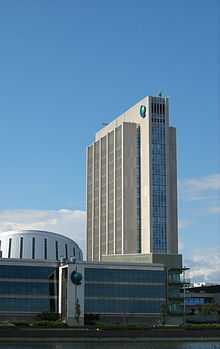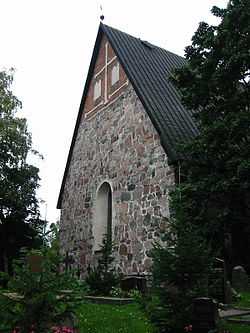Espoo
| Espoo Espoo – Esbo | ||
|---|---|---|
| Town | ||
| Espoon kaupunki Esbo stad | ||
|
Skyline of Espoo | ||
| ||
 Location of Espoo in Finland | ||
| Coordinates: 60°12′20″N 024°39′20″E / 60.20556°N 24.65556°ECoordinates: 60°12′20″N 024°39′20″E / 60.20556°N 24.65556°E | ||
| Country | Finland | |
| Region | Uusimaa | |
| Sub-region | Greater Helsinki | |
| Charter | 1458 | |
| City | 1972 | |
| Government | ||
| • City manager | Jukka Mäkelä | |
| Area (2011-01-01)[1] | ||
| • Total | 528.14 km2 (203.92 sq mi) | |
| • Land | 312.26 km2 (120.56 sq mi) | |
| • Water | 215.88 km2 (83.35 sq mi) | |
| Area rank | 221st largest in Finland | |
| Population (2014-11-30)[2] | ||
| • Total | 265,201 | |
| • Rank | 2nd largest in Finland | |
| • Density | 849.3/km2 (2,200/sq mi) | |
| Population by native language[3] | ||
| • Finnish | 83.6% (official) | |
| • Swedish | 8.3% (official) | |
| • Others | 8% | |
| Population by age[4] | ||
| • 0 to 14 | 19.7% | |
| • 15 to 64 | 69.8% | |
| • 65 or older | 10.5% | |
| Time zone | EET (UTC+2) | |
| • Summer (DST) | EEST (UTC+3) | |
| Municipal tax rate[5] | 17.75% | |
| Website | www.espoo.fi | |

Espoo (Finnish pronunciation: [ˈespoː]; Swedish: Esbo, [ˈɛsbo]) is the second largest city and municipality in Finland. The population of the city of Espoo is 265 646 (31.12.2014).[6] It is part of the Capital region and most of its population lives in the inner urban core of the Helsinki metropolitan area, along with the cities of Helsinki, Vantaa, and Kauniainen. Espoo shares its eastern border with Helsinki and Vantaa, while enclosing Kauniainen. The city is on the shore of the Gulf of Finland, in the region of Uusimaa.
Other bordering municipalities of Espoo are Nurmijärvi and Vihti in the north and Kirkkonummi in the west. The national park of Nuuksio is situated in northwest Espoo.
Espoo encompasses 528 square kilometres (204 sq mi), of which 312 km2 (120 sq mi) is land.[1]
Espoo has several local regional centers. Espoo is thus divided into seven major areas (Finnish: suuralueet, Swedish: storområden): Vanha-Espoo (with administrative center), Suur-Espoonlahti, Pohjois-Espoo, Suur-Kauklahti, Suur-Leppävaara, Suur-Matinkylä and Suur-Tapiola.
Aalto University is based in Otaniemi, Espoo, along with a thriving science community that includes numerous startups and organizations such as VTT – the Technical Research Center of Finland. Several major companies are based in Espoo, including Nokia Solutions and Networks, Microsoft Mobile, KONE, Neste Oil, Fortum, Orion Corporation and Outokumpu as well as video game developers Rovio and Remedy Entertainment.
The city of Espoo is officially bilingual. The majority of the population, 83.6%, speaks Finnish as their mother tongue, while a minority of 8.3% speaks Swedish. 8% of Espoo's population has a first language other than Finnish or Swedish.
History
The first inhabitants in the area arrived about 9,000 years ago. Physical evidence (pollen grains) indicates agriculture from ca. 1000 AD, but there are no historical records. Up to the 13th century, the area was a borderland between the hunting grounds of Finnish Proper and Tavastian Finns, with a sparse population. Immigrants from Sweden established permanent agricultural settlements during the 12th and 13th centuries, assimilating the sparse local Finnish-speaking population. Espoo was a subdivision of the Kirkkonummi congregation until 1486-7. The oldest known document referring to Kirkkonummi is from 1330; Espoo as a subchapter has been dated to the 1380s, although the first document directly referring to Espoo is from as late as 1431. The construction of the Espoo Cathedral, the oldest preserved building in Espoo, marks the independence of Espoo. Administratively, Espoo was a part of Uusimaa. When the province was split to Eastern and Western provinces governed from the Porvoo and Raasepori castles, respectively, the eastern border of the Raasepori province was in Espoo. The 13th century road connecting the most important cities in Finland at that time, the King's Road passes through Espoo on its way from Stockholm via Turku and Porvoo to Viipuri.
In 1557, King Gustaf Wasa decided to stabilize and develop the region by founding a royal mansion in Espoo. The government bought the villages of Espåby and Mankby (Finnish: Mankki) and transferred the population elsewhere, and built the royal mansion in Espåby. (Mankby was eventually abandoned and was never repopulated.) The royal mansion housed the king's local plenipotentiary (vogt), and collected royal tax in kind paid by labor on the mansion's farm. The administrative center Espoon keskus has grown around the church and the Espoo railway station, but the municipality has retained a network-like structure of to the modern day.
In 1920, Espoo was only a rural municipality of about 9,000 inhabitants, of whom 70% were Swedish speaking. Agriculture was the primary source of income, with 75% of the population making their living from farming. Kauniainen was separated from Espoo in 1920, and it gained city rights the same year as Espoo, in 1972.
Espoo started to grow rapidly in the 1940s and '50s. It quickly developed from a rural municipality into a fully-fledged industrial city, gaining city rights in 1972. Due to its proximity to Helsinki, Espoo soon became popular amongst people working in the capital. In the fifty years from 1950 to 2000, the population of Espoo grew from 22,000 to 210,000. Since 1945, the majority of people in Espoo have been Finnish speaking. In 2006, the Swedish speaking inhabitants represented barely 9% of the total population. The population growth is still continuing, but at a slower rate.
Name
The name Espoo probably comes from the Swedish name for the River Espoo, Espå (or Espåå), which in turn comes from the old Swedish word äspe, meaning a border of aspen, and the Swedish word for "river", å, thus "a river bordered by aspen". The name was first mentioned in 1431. The banks of the River Espoo are even today populated heavily with aspen.
Demographics
| Historical population of Espoo[7] | |||
|---|---|---|---|
| Year | Population | Year | Population |
| 1901 | 5,888 | 1985 | 156,778 |
| 1910 | 7,891 | 1990 | 172,629 |
| 1920 | 8,817 | 1995 | 191,247 |
| 1930 | 11,370 | 2000 | 213,271 |
| 1940 | 13,378 | 2005 | 231,704 |
| 1950 | 22,878 | 2010 | 247,970 |
| 1960 | 53,042 | 2013 | 260,753 |
| 1970 | 92,655 | 2020 (est.) | 281,970 |
| 1975 | 120,632 | 2030 (est.) | 306,965 |
| 1980 | 137,409 | 2040 (est.) | 323,875 |
| Population by grand district (in 2006) | |||
| Area | Population | Area | Population |
| Leppävaara | 58,048 | Vanha-Espoo | 33,613 |
| Espoonlahti | 48,649 | Pohjois-Espoo | 9,754 |
| Tapiola | 41,905 | Kauklahti | 6,191 |
| Matinkylä | 33,613 | ||
The population by nationality 1 January 2007 was 95.1% Finnish and 4.9% other nationalities. Religious affiliation was 77.4% Lutheran, 1.3% Orthodox, 1.3% other, 19.9% no religious affiliation.
Espoo contains many high income suburbs, and six out of the ten highest average income postal code areas in Finland are in Espoo.
Politics
Results of the Finnish parliamentary election, 2011 in Espoo:
- National Coalition Party 40.4%
- True Finns 14.6%
- Social Democratic Party 14.4%
- Green League 11.6%
- Swedish People's Party 6.7%
- Centre Party 4.3%
- Left Alliance 3.6%
- Christian Democrats 2.7%
Espoo's city council has 75 members. Following the municipal election of 2012 the council seats are allocated in the following way: National Coalition Party 29 seats, Greens 13, Social Democrats 10, True Finns 10, Swedish People's Party 7, Centre Party 2, Left Alliance 2, Christian Democrats 2.[8]
Culture
Espoo hosts a Museum of Modern Art called EMMA (Espoo Museum of Modern Art), built in a renovated old print house, the WeeGee house, named after an old book print company Weilin & Göös. The same building hosts also Finland's only Museum of Horology (Finnish: Kellomuseo, Swedish: Urmuseum) and a Toy Museum. Glims Farmstead Museum is also located in the city. The Espoo cultural centre, where numerous concerts and theater performances are held, is located in Tapiola (Swedish: Hagalund).
Espoo has several manors two of which are open to the public. The most important is Espoon kartano (Swedish: Esbo gård, Espoo Manor), mentioned first time in 1495, and belonging to the noble Ramsay family since 1756. The current main building dates from 1914, but a mill dates from the 1750s and Finland oldest walved stone bridge from 1777 is on the King's Road (Finnish: Kuninkaantie, Swedish: Kungsvägen) which passes by the manor. The main building can be rented for weddings and similar occasions. Guided tours on request for groups. The other manor open to public is Pakankylän kartano, located on the northern shore of Lake Bodom. The manor hosts a restaurant and club rooms, partly with original furniture open to the public, but meant original to Kaisankoti sanatory and old people's home located on ground of the manor.
The Metal band Children of Bodom comes from Espoo, Finland. They are named after the unsolved murder known as the Lake Bodom murders which took place at Lake Bodom, a lake in northern Espoo in 1960. The bands Norther and Kiuas also come from Espoo.
The educational department takes part in Lifelong Learning Programme 2007–2013 in Finland.
Sports
At the 1952 Summer Olympics, the city's Westend Tennis Hall hosted the fencing events.
Espoo is home to several premier league sports teams. The Espoo Blues play at Barona Areena in the SM-liiga – professional ice hockey league. The club was established in February 1984 as "Kiekko-Espoo" and played their first season in 1984–1985 in the Finnish Second Division. In 1988 they achieved a place on the Finnish First Division and in 1992 they celebrated their promotion to the SM-liiga. The club and the team changed their name in 1998. The name came from the dominant colour of their home jersey. The full name of the club is Blues Hockey Oy. The Blues are a contender for the title almost every year, but have yet to win the series. They have come second two times though, most recently in 2011.
FC Honka, is a football club. It was promoted into the Finnish premier division (Veikkausliiga) for the first time in its history at the end of the 2005 season. They play home matches at Tapiolan urheilupuisto. Originally founded in 1953 as "Tapion Honka", the name was changed into FC Honka in 1975. Honka is largely known in Finland for its extensive youth scheme with over 1000 young players playing in various age groups.
Espoo is the birthplace of 2007 Formula One World Champion Kimi Räikkönen, former Dallas Stars forward Jere Lehtinen (three time NHL Selke Trophy winner), former Formula One driver JJ Lehto, professional downhill mountain biker Matti Lehikoinen, professional ten-pin bowling star Osku Palermaa and 2009 European Figure Skating Champion Laura Lepistö.
| Club | Sport | League | Stadium |
|---|---|---|---|
| Espoo Blues | Ice hockey | SM-liiga | Barona Areena |
| Espoo Blues | Ice hockey | Women's SM series | Laaksolahti Arena |
| FC Honka Espoo | Football | Kakkonen | Tapiolan urheilupuisto |
| Espoon Oilers | Floorball | Salibandyliiga | Tapiolan urheiluhalli |
| Tapiolan Honka | Basketball | Korisliiga | Tapiolan urheiluhalli |
Gallery
-

The headquarters of Fortum, located in Keilaniemi, Espoo
-

Aalto University main building in Otaniemi, Espoo
-

Espoo Cathedral
-

Leppävaara railway station
-

Träskända Mansion in Espoo
-
Haukilahti marina
Twin towns – Sister cities
Espoo is twinned with:[9]

|
See also
- The UN's Convention on Environmental Impact Assessment in a Transboundary Context, signed in Espoo 1991 (text of Convention)
- Districts of Espoo
- Pakankylä
- Postipuu School
- Sello mall shooting
References
Notes
- ↑ 1.0 1.1 "Area by municipality as of 1 January 2011" (PDF) (in Finnish and Swedish). Land Survey of Finland. Retrieved 9 March 2011.
- ↑ "VÄESTÖTIETOJÄRJESTELMÄ REKISTERITILANNE 30.11.2014" (in Finnish and Swedish). Population Register Center of Finland. Retrieved 29 December 2014.
- ↑ "Population according to language and the number of foreigners and land area km2 by area as of 31 December 2008". Statistics Finland's PX-Web databases. Statistics Finland. Retrieved 29 March 2009.
- ↑ "Population according to age and gender by area as of 31 December 2008". Statistics Finland's PX-Web databases. Statistics Finland. Retrieved 28 April 2009.
- ↑ "List of municipal and parish tax rates in 2011". Tax Administration of Finland. 29 November 2010. Retrieved 13 March 2011.
- ↑ http://vrk.fi/default.aspx?docid=8639&site=3&id=0
- ↑ Tilastokeskus. "Population statistics", Tilastokeskus, Retrieved on 9 June 2014.
- ↑ "Espoo - Tulospalvelu - Kuntavaalit 2012". Vaalikone.fi. Retrieved 2013-03-26.
- ↑ "Twin towns". Espoo. Retrieved 28 April 2014.
- ↑ "Interactive City Directory". Sister Cities International. Retrieved 12 March 2014.
Sources
- Espoon kaupungin taskutilasto 2007, issued by the City of Espoo, 2007
External links
| Wikimedia Commons has media related to Espoo. |
| Wikivoyage has a travel guide for Espoo. |
- 1952 Summer Olympics official report. p. 50.
- City of Espoo – Official website (Finnish)
- City of Espoo (Esbo) – Official website (Swedish)
- City of Espoo – Official website (English)
- Visit Espoo Espoo for travellers (Finnish) (Swedish) (English)
- Helsinki University of Technology – located in Espoo (Finnish) (Swedish) (English)
- Helsinki.fi – Helsinki region in a nutshell (Finnish) (Swedish) (English)




